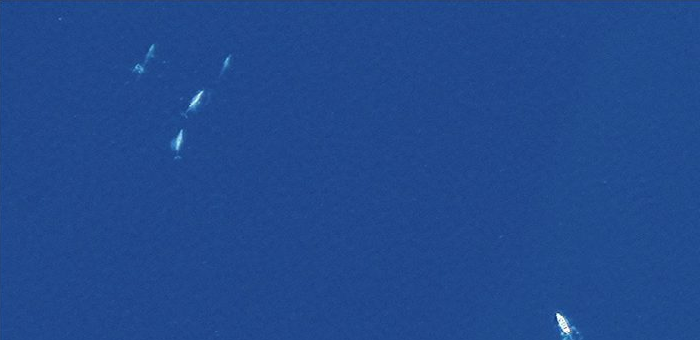Scientists have used high-resolution satellite images to detect, measure and describe four different species of whales. This study is considered a big step towards developing a method to study whales in remote and inaccessible places, in order to help scientists monitor them an understand their behaviour.
Each species was noted in one of their known aggregation areas, where individuals gather. Namely, southern right whales were spotted off Argentina, humpback whales off Hawaii, fin whales in the Pelagos Sanctuary in the Mediterranean and grey whales off the coast of Mexico.
[smlsubform prepend=”GET THE SAFETY4SEA IN YOUR INBOX!” showname=false emailtxt=”” emailholder=”Enter your email address” showsubmit=true submittxt=”Submit” jsthanks=false thankyou=”Thank you for subscribing to our mailing list”]
This has helped whale conservation bodies to identify 10 key inaccessible whale populations that would benefit most from the application of satellite imagery in studies.
Lead author Hannah Cubaynes, a whale ecologist at British Antarctic Survey (BAS) and University of Cambridge, commented on the occasion:
Whales live in all oceans. Many areas are difficult to access by boats or planes, the traditional means of monitoring whales. The ability to track whales without travelling to these remote and inaccessible areas, in a cost-effective way, will be of great benefit to conservation efforts for whales
The study also indicates that some species are easier to identify by satellite. For example fin and grey whales are the easiest to identify because of their body colouration, which contrasts with surrounding water. Humpback whales and southern right whales are more difficult to notice as they are a similar colour to their environment. Especially the acrobatic behaviour of humpback whales makes them harder to see as they splash about so much and so their body shape is often obscured.
Now, whale ecologist Dr Jennifer Jackson at BAS, an author on the paper, will start an expedition to the sub-Antarctic island of South Georgia in December to study southern right whales. She believes that this technology could be a game-changer in helping find whales remotely. Specifically, endangered whale populations like the Chile-Peru right whale could really benefit from this approach.
Satellite-based technology could prove very useful for measuring trends in whale populations such as these southern right whales, in future
MAVA Foundation and the UK Natural Environment Research Council funded the project.





























































